I’ve spent the last few hours (after getting home from a swift pint in the pub admittedly) having one of those satisfying coding experiences where the dots just start joining up… I took the very nicely written OpenIDenabled PHP library and bolted it on to the authentication routines for PROD.
The technical principles behind OpenID are simple enough: the user tells your application their openid URL, the app asks the relevant provider if everything is ok, the provider comes back and tells the app a whole bunch of stuff saying that the user is kosher (or halal or whatever it says in their profile).
The latest version of the toolkit made this a breeze – coming as it does with working examples and very well documented code. Most of the work was putting in a few new hooks in my authentication script to catch both ends of the transaction, copying and pasting some code from the example scripts to create the consumer object and set it flying and finally catching the response at the end and telling my application that the user is now logged in.
As with most quick work there is still quite a bit tidying up to do – particularly around how I associate existing users in the LDAP directory with their OpenIDs… At the moment I’m just not bothering. Useful error messages would probably be a good idea too! Testing it with a few different providers is also a must.
One gotcha I discovered was that at some point the exact recipe for doing Delegation must have changed and that the library is more fussy about this than other implementations I’ve seen and used. When testing using my own domain’s delegation which I’ve had set up for years it was consistently failing. This is not good news as there are probably thousands of people who still have it set up exactly as I did…
Another (Ubuntu specific) issue was that it was failing to authenticate against yahoo’s service because I was missing some bits of openssl… This was fixed with a quick sudo apt-get install openssl ca-certificates
Now I’ve had a few brushes in recent months with OpenID mainly around the web provision for the XCRI project – where we got OpenID working across WordPress, Mediawiki, and (through some rather cheap hacking) BBpress. It was however reliant on plugins for said apps and never really a very satisfactory experience – generating a long string of complaints from users getting very variable results depending on which provider they were using. Upgrading any particular component of the site seemed to just lead to more chaos.
Sadly I think that these variable experiences do rather detract from the potential that OpenID has to help us all better manage our online identities. That and the insistence of so many “providers” like Yahoo! and WordPress.com that they are just that, providers and not consumers. I’ve already got about 6 OpenIDs on the go without really realising – useful for testing but the exact opposite of the single authentication service goal. Tsk tsk.
Anyway… Now that I’ve actually tackled the problem at a slightly deeper level I’m feeling confident that over time we can not only iron out XCRI’s woes but also introduce OpenID across the JISC CETIS (and IEC) services in a reasonably robust way. The future looks rosy, the sky is blue, thunderclouds? What thunderclouds?
